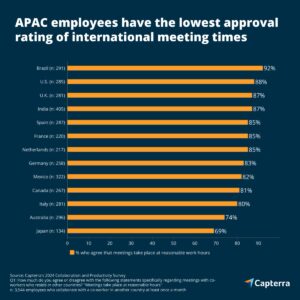Global HR leaders grapple with myriad obstacles in fostering seamless collaboration among a dispersed workforce spanning different countries.
Statistics reveal that 59% of employees worldwide are novices in working together with colleagues stationed abroad. This unfamiliar territory gives rise to a host of issues including fluctuating work schedules (44%), language barriers (42%), and cultural misinterpretations (33%).
Brian Westfall, the principal HR analyst at Capterra, underscores that merely relying on virtual meeting platforms won’t resolve the complexities of international teamwork. “HR leaders and project managers must recognise the nuances in time zones, languages, and cultures that influence cross-border collaboration,” Westfall stated.
Navigating time zone challenges
As outlined in a recent report, hurdles in international workplace collaboration manifest diversely across the globe. While employees in the United States contend with a maximum seven-hour time difference with their regular collaborators, a substantial majority (88%) perceive international meeting schedules as reasonable.
Conversely, counterparts in Japan (69%) and Australia (74%) lament the impracticality of meeting during standard work hours, often bearing the brunt of scheduling meetings at odd times to sync with colleagues in the Americas and Europe.
To mitigate this, Capterra recommends considering a rotational approach to meeting times, particularly for organisations with a significant presence in the APAC region.

Language barrier dilemmas
Language disparities pose another formidable challenge, with 62% of respondents reporting collaboration with colleagues whose native language differs from their own. This issue is exacerbated during international meetings, where more than half of employers neglect essential measures to assist non-native speakers.

Cultural variances
The report further unveils divergent perceptions of collaboration across cultures. While over 80% of employees in the Netherlands favor in-person team bonding, 52% prefer virtual interactions. Despite this, a significant proportion of respondents (86%) believe their country is adequately represented in their company’s culture, a sentiment less pronounced among Japanese employees (64%).
This disparity may reflect deficiencies in diversity, equity, and inclusion initiatives, which organisations can rectify through employee resource groups.
Mitigating workplace challenges
The report emphasises the urgency of overcoming these obstacles, given the escalating trend of international collaboration amid the remote work surge. Technology is touted as a pivotal tool in addressing these challenges, with 86% of employees acknowledging software solutions as facilitators of collaboration.
Capterra emphasises the importance of consistency in virtual meetings, particularly concerning timing, and advocates for a comprehensive understanding of when email or instant messaging suffices over scheduling meetings.











